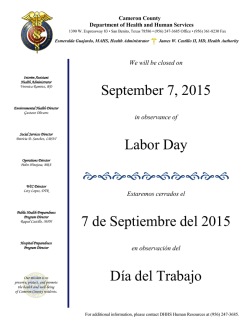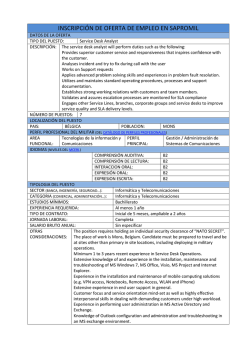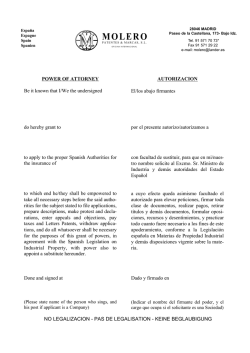
(Agassiz, 1835) found in the province of Seville
First description of a tooth of the extinct giant shark Carcharocles megalodon (Agassiz, 1835) found in the province of Seville (SW Iberian Peninsula) (Otodontidae) Primera descripción de un diente del extinto tiburón gigante Carcharocles megalodon (Agassiz, 1835) encontrado en la provincia de Sevilla (SO de la Península Ibérica) (Otodontidae) José Luis Medina-Gavilán 1, Antonio Toscano 2, Fernando Muñiz 3, Francisco Javier Delgado 4 1. Sociedad de Estudios Ambientales (SOCEAMB) − Perú 4, 41100 Coria del Río, Sevilla (Spain) − [email protected] 2. Departamento de Geodinámica y Paleontología, Facultad de Ciencias Experimentales, Universidad de Huelva − Campus El Carmen, 21071 Huelva (Spain) − [email protected] 3. Departamento de Geodinámica y Paleontología, Facultad de Ciencias Experimentales, Universidad de Huelva − Campus El Carmen, 21071 Huelva (Spain) − [email protected] 4. Usuario de BiodiversidadVirtual.org − Álvarez Quintero 13, 41220 Burguillos, Sevilla (Spain) − [email protected] ABSTRACT: Fossil remains of the extinct giant shark Carcharocles megalodon (Agassiz, 1835) are rare in interior Andalusia (Southern Spain). For the first time, a fossil tooth belonging to this paleospecies is described from material found in the province of Seville (Burguillos). KEY WORDS: Carcharocles megalodon (Agassiz, 1835), megalodon, Otodontidae, fossil, paleontology, Burguillos, Seville, Tortonian. RESUMEN: Los restos del extinto tiburón gigante Carcharocles megalodon (Agassiz, 1835) son raros en el interior de Andalucía (sur de España). Por primera vez, se describe un diente fósil de esta paleoespecie a partir de material hallado en Sevilla (Burguillos). PALABRAS CLAVE: Carcharocles megalodon (Agassiz, 1835), megalodón, Otodontidae, fósil, paleontología, Burguillos, Sevilla, Tortoniense. Introduction Carcharocles megalodon (Agassiz, 1835), the megalodon, is widely recognised as the largest shark that ever lived. This paleospecies is the last of a chronoseries of large Cenozoic sharks included in the extinct family Otodontidae, usually referred to in paleontological literature by the suggestive name of “megatoothed sharks”. The name is an allusion to typical large and robust teeth of this group, which dominate the fossil record due to the generally unpreserved nature of the cartilaginous skeleton of chondrichthyans. In fact, one BVnPC, 4 (57): 107-114 (2015) 107 single tooth of C. megalodon can exceed more than 15 cm of total height, reaching maximum sizes at anterior and lateral positions on the upper jaw. From biometrical estimates based on teeth and vertebrae size, it is obtained that the body of C. megalodon could reach a maximum total length of nearly 17 meters and a mass around 60 tons (GOTTFRIED et al., 1996; PIMIENTO et al., 2010). The fossil record reveals that C. megalodon was distributed in warm shallow seas all over the world, from Middle Miocene to Upper Pliocene (APPLEGATE & ESPINOSA-ARRUBARRENA, 1996). From a trophic viewpoint, it is assumed that C. megalodon was a dominant top predator specialized in cetaceans and sirenians. This assertion is supported on the basis of: its skeletal and tooth anatomy (GOTTFRIED et al., 1996; DIEDRICH, 2013); its estimated bite force (WROE et al., 2008); the coexistence of megalodon teeth and fossilized prey bones with predation or scavenging marks (DEMÉRÉ & CERUTTI, 1982; PURDY, 1996; AGUILERA & RODRIGUES DE AGUILERA, 2004; AGUILERA et al., 2008); the preservation of megalodon teeth with mechanical traumas, attributable to feeding injuries (BALBINO & ANTUNES, 2007; BECKER & CHAMBERLAIN, 2012; DIEDRICH, 2013); and the evolutionary correlation between megalodon speciation and marine mammals diversification, during the middle Miocene (DIEDRICH, 2013). So, the extinct C. megalodon played a similar ecological role as the coetaneous ancestor of the extant great white shark, Carcharodon carcharias (Linnaeus, 1758) (EHRET et al., 2008; DIEDRICH, 2013). Their homologous dentitions have also conducted classical authors to consider a close phylogenetic relationship between them, in such a way that megatoothed sharks have been interpreted as proximal ancestors of Carcharodon. Moreover, megalodon has even been included within the genus Carcharodon (BENDIX-ALMMGREN, 1983; APPLEGATE & ESPINOSA-ARRUBARRENA, 1996). However, it is currently accepted that Carcharocles (Otodontidae) and Carcharodon (Lamnidae) are well differentiated lineages (NYBERG et al., 2006; EHRET et al., 2012), whose common ancestors go back to the period Cretaceous (SIVERSSON et al., 2015). Finally, C. megalodon disappeared at the end of Neogene (APPLEGATE & ESPINOSA-ARRUBARRENA, 1996), coinciding with the gradual global cooling which occurred during the late Pliocene (RAVELO et al., 2004). In the Iberian Peninsula, C. megalodon have been found on miocenic, and to a lesser extent pliocenic, coastal-shelf sedimentary deposits from Catalonia, Valencian Community, Murcia, Andalusia and centre and south Portugal (MENDIOLA & MARTÍNEZ, 2003; ANTUNES & BALBINO, 2010). Additionally, megalodon fossils also seem to have been collected on the border of the continental platform in Galicia (BIANUCCI et al., 2013). Unfortunately, there are no global studies that focus on the Neogene chondrichthyan fauna in southwest Spain, with the exception of those restricted to the province of Huelva (GARCÍA, 2008). In the province of Seville, the public knowledge on C. megalodon is reduced to scarce bibliographical cites (CALDERÓN, 1893; MAESTRE et al., 2008) and a few fossils conserved in academic collections (GALÁN HUERTOS et al., 2002). Although megalodon is relatively rarer than other shark fossil species (BALBINO & ANTUNES, 2003), this poor regional recording contrasts with the expectation stimulated by the geological history of south Iberia during the Miocene (MARTÍN et al., 2014), with paleoenvironments suitable for its survival and the preservation of its remnants. In fact, recently, megalodon teeth have been appearing sporadically in private collections from Seville, whose owners usually find the fossils while they are working arable lands (F. Muñiz, pers. obs.). Therefore, the aim of this note is to put on record a new fossil of Carcharocles megalodon in the province of Seville and describe it in detail, contributing to the diffusion and conservation of the Andalusian paleontological patrimony. Results and discussion Systematic paleontology: - Class Chondrichthyes Huxley, 1880 - Subclass Elasmobranchii Bonaparte, 1838 - Order Lamniformes Berg, 1958 - Family Otodontidae Glickmann, 1964 - Genus Carcharocles Jordan and Hannibal, 1923 - Carcharocles megalodon (Agassiz, 1835) Synonymy: Carcharias megalodon Agassiz, 1835; Carcharodon megalodon Agassiz, 1835; Otodus megalodon Agassiz, 1835; Procarcharodon megalodon Casier, 1960; Megaselachus megalodon Glickmann, 1964. BVnPC, 4 (57): 107-114 (2015) 108 Material: One adult, lower left anterior tooth (specimen MGR001; 8-VIII-2014). The piece was subjected to a cleaning treatment with caustic potash (KOH). Repository: Grupo de Investigación RNM293: Geomorfología Ambiental y Recursos Hídricos, Facultad de Ciencias Experimentales, Campus de El Carmen, Universidad de Huelva, 21071, Huelva (Spain). Site: The fossil was located in Burguillos (Seville province, SW Spain), at “Haza de los Bodegones” site (UTM ETRS89 30S 236182 4165839 m), between “Cortijo Cardona” houses and the road from Alcalá del Río to Castilblanco de los Arroyos (A-8013) at 130 m above sea level. The piece was found on the top surface of the soil, not buried (Fig. 1). This circumstance is not strange, since the substrate has been frequently stirred as a consequence of the secular exploitation of this zone as cropland. Estimated age: Upper Miocene (Upper Tortonian); (IGME, 1976). Description: The specimen is a large, almost full size tooth –except for the tip of the crown, that is broken–, its overall form is an isosceles triangle (Fig. 2). As preserved, maximal width and height is 100.4 mm and 118.9 mm respectively. However, the original tooth would have been slightly wider and higher than the measurements indicated. After biometrical comparisons with other pieces, we estimated the total height being 134.6 mm (Fig. 3). Fig. 1: Untreated fossil, at “Haza de los Bodegones” site (lingual view), 18-VIII-2014, (MEDINA, 2015a). http://www.biodiversidadvirtual.org/geologia/Diente-de-Carcharocles-megalodon-img6948.html BVnPC, 4 (57): 107-114 (2015) 109 Fig. 2: Clean fossil: A. Lingual view; B. Labial view; C. Lateral view, 18-VIII-2015, (MEDINA, 2015b). http://www.biodiversidadvirtual.org/geologia/Diente-de-Carcharocles-megalodon-img6949.html The crown is triangular, straight and symmetrical with slightly concave mesial and distal edges (Fig. 2). The conserved fraction of crown has a basal width of 87.1 mm and height of 67.8 mm (Fig. 3). The internal (lingual) face is convex and the external (labial) face is flat, whereas the tooth thickness is increasing regularly from the tip of the crown to the baseline of it (Fig. 2C). In this species, the enamel is smooth on both labial and lingual sides. The cutting edges are provided with relatively small crenulation or serration, uniform, very fine and numerous, and bluntly pointed; however, it is absent in this tooth due to its bad preservation. The enameloid in the base of the crown scarcely overlaps the root and it is substantially parallel to its basal edge, being simply concave on the labial face and indented at an inversed “V” shape in the lingual view, called neck or chevron, that characterizes this species. Despite the poor preservation of the tooth surface, the chevron is clearly noticeable (Figs. 2A and 3). The root is very massive since it alone forms more than a third of the total height of the tooth. It is high with well developed root lobes, forming an acute angle. The root shows a flat and well developed labial face (Fig. 2B), whereas its lingual face presents a marked protuberance or torus, bearing a nutrient pore called foramen (Figs. 2A and 3). The notch of the basal edge is also well marked. Based on these characteristics, the piece may probably be a lower left anterior tooth. Fig. 3: Morphology and biometrical parameters (lingual view). [st: estimated dimensions of the lost fraction; ds: distal side; ms: mesial side]. BVnPC, 4 (57): 107-114 (2015) 110 Taphonomic considerations: The tooth is almost complete except for the tip of the crown. The sharp edges indicate a late fracture because of having been exposed to severe abrasion, otherwise the edges would be rounded. Moreover, the tooth has lost its superficial layer, making complete and accurate measurements problematic. The lack of this layer is homogeneous throughout the tooth and does not show wear facets; its absence is not caused by erosion but rather by chemical dissolution. Carcharocles had osteodont teeth, characterized by having osteodentine filling the core of the crown (no large pulp cavity), surrounded by orthodentine, pallial dentine and covered by a thin enameloid layer (analogous to mammalian enamel). The root entirely consists of osteodentine. This dissolution has removed the outer layer of enameloid and pallial dentine in the crown, exposing the internal microstructure of the tooth, formed by orthodentine in the crown and osteodentine on the root, a more vascular and spongy bone-like tissue. The non-mineralized portion of the tooth consists of vascular canals and dental tubules, which produce the characteristic porous or punctate surface texture (Fig. 4). Fig. 4: Non-mineralized portion of the tooth, 7-XII-2014, (MEDINA, 2015c). http://www.biodiversidadvirtual.org/geologia/Textura-porosa-de-diente-de-Carcharocles-megalodonimg6950.html Paleoecological context: During the Tortonian transgression, lands currently included in the territorial boundaries of Burguillos were part of a littoral system extended along the passive margin of the Guadalquivir Basin. The reconstruction of this paleoenvironment reveals that a great part of Burguillos was submerged under a shallow and warm mass of seawater, with Atlantic origin (ABAD, 2007). Particularly, Haza de los Bodegones site seems to correspond with a transgressive marine facies dominated by bioclastic calcarenites and characterized by the presence of certain bioindicators (ostreids, pectinids, Clypeaster sp., Balanus sp.), which resemble those facies described in near zones (RICO-GARCÍA et al., 2006; ABAD, 2007). Following ABAD (2007), the depth of the water column can be estimated between 10 and 50 m. For its physical attributes, this region could represent a suitable habitat for the giant C. megalodon as an aggregation center for feeding, reproduction and/or nursery (PIMIENTO et al., 2010). Regarding potential preys, the northern margin of the Guadalquivir Basin gathered a rich cetacean fauna (e.g. TOSCANO et al., 2013); so, in Burguillos, abundant whale remnants have been found (BERNÁLDEZ SÁNCHEZ, 1998; J. L. Medina-Gavilán, F. J. Delgado, F. Muñiz, pers. obs.). Further remarks: With respect to C. megalodon presence in western Andalusia, it would be recommendable to inventory fossil material collected by amateurs, for example, through a field study based on personal interviews. Besides, it is expected that this note helps to raise the interest of society, not only BVnPC, 4 (57): 107-114 (2015) 111 researchers, on the knowledge, diffusion and protection of their local paleontological patrimony. A responsible intervention by local authorities is needed in this matter; particularly in Burguillos, where some valuable samples have been lost forever (e.g. one cetacean skeleton under the municipal building “Carmen Laffon”, in 2005). Acknowledgments To Manuel García, co-discoverer of the megalodon tooth for providing the study material and to the research group RNM293 (Geomorfología Ambiental y Recursos Hídricos, Universidad de Huelva). We also owe particular thanks to Asociación Fotografía y Biodiversidad and to the editorial team of the journal BV news Publicaciones Científicas for their altruistic dedication to the cause of biodiversity and geodiversity conservation. Special thanks to Anja von Seth for the language revision of the manuscript. References ABAD, M. (2007). La transgresión tortoniense en el margen pasivo de la cuenca del Guadalquivir: respuesta estratigráfica e implicaciones paleontológicas. Huelva. Universidad de Huelva. 510 pp. AGUILERA, O., GARCÍA, L. & COZZUOL, M. A. (2004). Giant-toothed white sharks and cetacean trophic interaction from the Pliocene Caribbean Paraguaná formation. Paläontologische Zeitschrift, 82: 204208. AGUILERA, O. & RODRIGUES DE AGUILERA, D. (2004). Giant-toothed white sharks and wide-toothed Mako (Lamnidae) from the Venezuela Neogene: their role in the Caribbean, shallow-water fish assemblage. Caribbean Journal of Science, 40: 368-382. ANTUNES, M. T. & BALBINO, A. C. (2010). The great white shark Carcharodon carcharias (Linné, 1758) in the Pliocene of Portugal and its early distribution in eastern Atlantic. Revista Española de Paleontología, 25: 1-6. APPLEGATE, S. P. & ESPINOSA-ARRUBARRENA, L. (1996). The fossil history of Carcharodon and its possible ancestor, Cretolamna: a study in tooth identification. In: KLIMLEY, A. P. & AINLEY, D. G. (eds.): Great White Shark. The Biology of Carcharodon carcharias. San Diego. Academic Press. 517 pp. BALBINO, A. C. & ANTUNES, M. T. (2003). Uppermost Miocene Lamniform Selachians (Pisces) from the Alvalade basin (Portugal). Ciências da Terra (UNL), 15: 141-154. BALBINO, A. C. & ANTUNES, M. T. (2007). Pathologic tooth deformities in fossil and modern sharks related to jaw injuries. Comptes Rendus Palevol, 6: 197-209. BECKER, M. A. & CHAMBERLAIN, J. A. (2012). Squalicorax chips a tooth: a consequence of feeding-related behavior from the Lowermost Navesink formation (Late Cretaceous: Campanian-Maastrichtian) of Monmouth County, New Jersey, USA. Geosciences, 2: 109-129. BENDIX-ALMGREEN, S. E. (1983). Carcharodon megalodon from the Upper Miocene of Denmark, with comments on elasmobranch tooth enameloid: coronoïn. Bulletin of the Geological Society of Denmark, 32: 1-32. BERNÁLDEZ SÁNCHEZ, E. (1998). Encontré un fósil y no supe qué hacer con él. PH Boletín, 24: 64-67. BIANUCCI, G., MIJÁN, I., LAMBERT, O., POST, K. & MATEUS, O. (2013). Bizarre fossil beaked whales (Odontoceti, Ziphiidae) fished from the Atlantic Ocean floor off the Iberian Peninsula. Geodiversitas, 35: 105-153. CALDERÓN, S. (1893). Estructura del terreno terciario del Guadalquivir en la provincia de Sevilla. Boletín Geológico y Minero, 20: 313-318. DEMÉRÉ, T. A. & CERUTTI, R. A. (1982). A Pliocene shark attack on a cethotheriid whale. Journal of Paleontology, 56: 1480-1482. DIEDRICH, C. (2013). Evolution of white and megatooth sharks, and evidence for early predation on seals, sirenians, and whales. Natural Science, 5: 1023-1218. EHRET, D. J., MACFADDEN, B. J., JONES, D. S., DEVRIES, T. J., FOSTER, D. A. & SALAS-GISMONDI, R. (2012). Origin of the white shark Carcharodon (Lamniformes: Lamnodae) based on recalibration of the upper Neogene Pisco formation of Peru. Palaeontology, 55: 1139-1153. BVnPC, 4 (57): 107-114 (2015) 112 EHRET, D. J., MACFADDEN, B. J. & SALAS-GISMONDI, R. (2008). Caught in the act: trophic interactions between a 4-million-year-old white shark (Carcharodon) and Mysticete whale from Peru. Palaios, 24: 329-333. GALÁN HUERTOS, E., MAYORAL ALFARO, E. & GALÁN ÁVILA, P. (2002). Inventario actualizado del museo de geología. Sevilla. Universidad de Sevilla. Servicio de Publicaciones de la Universidad de Sevilla. 574 pp. GARCÍA, E. X. M. (2008). Condrictios y Osteíctios del Neógeno de Huelva (Formación “Arenas de Huelva”), Salamanca. Universidad de Salamanca. 313 pp. GOTTFRIED, M. D., COMPAGNO, L. J. V. & CURTIS BOWMAN, S. (1996). Size and skeletal anatomy of the giant “megatooth” shark Carcharodon megalodon. In: KLIMLEY, A. P. & AINLEY, D. G. (eds.): Great White Shark. The Biology of Carcharodon carcharias. San Diego. Academic Press. 517 pp. IGME (1976). Mapa geológico de España E 1:50.000. Alcalá del Río (Hoja 962). Madrid. Servicio de Publicaciones del Ministerio de Industria. MARTÍN, J. M., PUGA-BERNANÉU, A., AGUIRRE, J. & BRAGA, J. C. (2014). Miocene Atlantic-Mediterranean seaways in the Betic Cordillera (Southern Spain). Revista de la Sociedad Ecológica de España, 27: 175-186. MEDINA, J. L. (2015a). Diente de Carcharocles carcharodon. Photograph to be found on BiodiversidadVirtual.org [Online database]. Available from: http://www.biodiversidadvirtual.org/geologia/Diente-de-Carcharocles-megalodon-img6948.html. [Accessed 17-VIII-2015]. MEDINA, J. L. (2015b). Diente de Carcharocles carcharodon. Photograph to be found on BiodiversidadVirtual.org [Online database]. Available from: [Accessed 17-VIII-2015]. http://www.biodiversidadvirtual.org/geologia/Diente-de-Carcharocles-megalodon-img6949.html. MEDINA, J. L. (2015c). Textura porosa de diente de Carcharocles carcharodon). Photograph to be found on BiodiversidadVirtual.org [Online database]. Available from: http://www.biodiversidadvirtual.org/geologia/Textura-porosa-de-diente-de-Carcharocles-megalodonimg6950.html. [Accessed 17-VIII-2015]. MENDIOLA, C. & MARTÍNEZ, J. (2003). La ictiofauna fósil (Chondricthyes, Euselachii) del Mesozoico y Cenozoico de España. Revista de la Societat Paelontològica d’Elx, sección Paleontológica, 14: 1-51. NYBERG, K. G., CIAMPLAGIO, C. N. & WRAY, G. A. (2006). Tracing the ancestry of the great white shark, Carcharodon carcharias, using morphometric analyses of fossil teeth. Journal of Vertebrate Paleontology, 24: 806-814. PIMIENTO, C., EHRET, D. J., MACFADDEN, B. J. & HUBBEL, G. (2010). Ancient nursery area for the extinct giant skark Megalodon from the Miocene of Panama. PLoS ONE, 5: e10552. PURDY, R. W. (1996). Paleoecology of fossil white sharks. In: KLIMLEY, A. P. & AINLEY, D. G. (eds.): Great White Shark. The Biology of Carcharodon carcharias. San Diego. Academic Press. 517 pp. RAVELO, A. C., ANDREASEN, D. H., LYLE, M., OLIVAREZ LYLE, A. & WARA, M. W. (2004). Regional climate shifts caused by gradual global cooling in the Pliocene epoch. Nature, 429: 263-267. RICO-GARCÍA, A., CÁRDENAS-CARRETERO, J., GONZÁLEZ DELGADO, J. A. & CIVIS, J. (2006). Estudio paleontológico preliminar del Tortoniense superior de “Las Pajanosas” (Sevilla, Cuenca del Guadalquivir). Geogaceta, 39: 143-146. SIVERSSON, M., LINDGREN, J., NEWBREY, M. G., CEDERSTRÖM, P. & COOK, T. D. (2015). Late Cretaceous (Cenomanian-Campanian) mid-palaeolatitude sharks of Cretalamna appendiculata type. Acta Palaeontologica Polonica, 60: 339-384. TOSCANO, A., ABAD, M., RUIZ, F., MUÑIZ, F., ÁLVAREZ, G., GARCÍA, E. X. M. & CARO, J. A. (2009). Nuevos restos de Scaldicetus (Cetacea, Odontoceti, Physeteridae) del Mioceno superior, sector occidental de la Cuenca del Guadalquivir. Revista mexicana de Ciencias Geológicas, 30: 436-445. WROE, S., HUBER, D. R., LOWRY, M., MCHENRY, C., MORENO, K., CLAUSEN, P., FERRARA, T. L, CUNNIGHAM, E., DEAN, M. N. & SUMMERS, A. P. (2008). Three-dimensional computer analysis of white shark jaw mechanics: how hard can a great white bite? Journal of Zoology, 276: 336-342. BVnPC, 4 (57): 107-114 (2015) 113 BVnPC, 4 (57): 107-114 (2015) 114
© Copyright 2026






